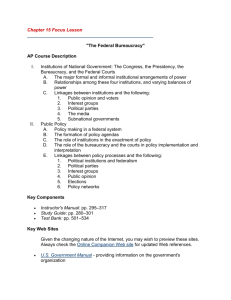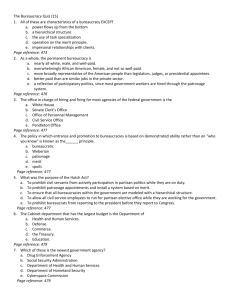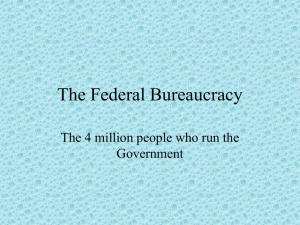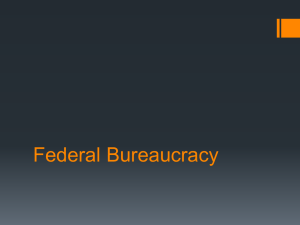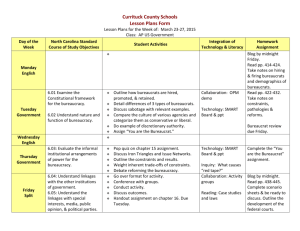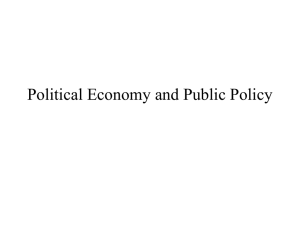The Federal Bureaucracy
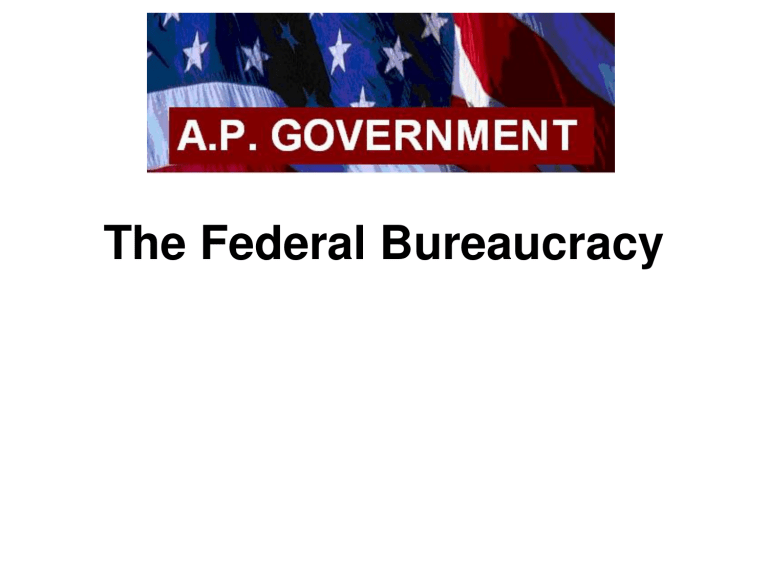
The Federal Bureaucracy
Introduction
Bureaucracy Defined
• Large, complex organization of appointed, not elected, officials.
• “bureau” – French for small desks, referring to the king’s traveling business men who set up small desks in town squares
• Bureaucracy = “government of small desks”
• Classic conception of bureaucracy
Max Weber, famous early 20 th century
German economist
– Hierarchical authority structure
– Uses task specialization
– Operate on the merit principle
– Behave with impersonality
– Wellorganized machine with lots of working parts.
Modern Bureaucracy
• 19321945 – New Deal, WWII, increase in programs and gov’t work
• 1950’s – 1970’s – 90% of all federal employees were chosen on merit
• Salaries also chosen on merit
I. The Bureaucrats
• 1 out of 100 Americans work for government bureaucracy
• Examples
– US Postal Service
– Amtrak
– Corporation for Public Broadcasting
– Interstate Commerce Commission
– Federal Trade Commisson
– Securities and Exchange Commission
– National Aeronautics and Space Administration
What do bureaucrats do?
• Discretionary action – have the power to execute laws and policies passed down by the president or congress.
• Implementation – develop procedures and rules for reaching the goal of a new policy
• Regulation – check private business activity
– Munn v. Illinois (1877) – SC upheld that government had the right to regulate business rates and services
• Some Bureaucratic Myths and Realities
– Americans dislike bureaucrats.
– Bureaucracies are growing bigger each year.
– Most federal bureaucrats work in Washington,
D.C.
– Bureaucracies are ineffective, inefficient and always mired in red tape.
• Growth in Civilian Government Employees
• Who They Are and How They Got There
– Most demographically representative part of government.
– Diversity of jobs mirrors the private sector.
Figure 15.2
• Who They Are and How They Got There
– Civil Service: From Patronage to Protection.
• Patronage: Job given for political reasons.
• Civil Service: System of hiring and promotion based on merit and nonpartisanship (Pendleton
Civil Service Act).
• Merit Principle: Entrance exams and promotion ratings to find people with talent and skill.
• Office of Personnel Management: The federal office in charge of most of the government’s hiring.
• Who They Are and How They Got There
– The Other Route to Federal Jobs: Recruiting from the Plum Book
• Lists the very top jobs available for Presidential appointment.
• Presidents work to find capable people to fill the positions.
• Some plum jobs (ambassadorships) are patronage.
• Their most important trait is transience.
II. How Bureaucracies
Are Organized
• The Cabinet Departments
– 13 Cabinet departments headed by a secretary
– Department of Justice headed by Attorney
General
– Each has its own budget, staff and policy areas
– Status as a cabinet department can be controversial.
• The Regulatory Agencies
– Independent Regulatory Agency: Responsible for some sector of the economy making rules and judging disputes to protect the public interest.
– Headed by a commission of 510 people.
– Rule making is an important function watched by interest groups and citizens alike.
– Concern over “capture” of the agencies.
• The Government Corporations
– Business like – provide services like private companies and typically charge for their services.
– Postal Service, Amtrak are examples
• Independent Executive Agencies
– The agencies that don’t fit in anywhere else.
– GSA and NASA are examples
III. Bureaucracies as
Implementers
• What Implementation Means
– It involves translating the goals and objectives of a policy into an operating, ongoing program.
– Implementation includes:
• Creating / assigning an agency the policy
• Translating policy into rules, regulations and forms.
• Coordinating resources to achieve the goals.
• Why the BestLaid Plans Sometimes Flunk the Implementation Test
– Program Design
– Lack of Clarity
• Congressional laws are ambiguous and imprecise.
• Sometimes the laws conflict with each other.
– Lack of Resources
• Agencies may be big, but not in the right areas.
• Why the BestLaid Plans Sometimes
Flunk the Implementation Test
– Lack of Resources
• Many different types of resources are needed: personnel, training, supplies & equipment.
• May also lack the authority to act.
– Administrative Routine
• SOPs bring uniformity to complex organizations.
• It is often difficult to change the routines.
• Why the BestLaid Plans Sometimes
Flunk the Implementation Test
– Administrator’s Dispositions
• Administrative discretion is the ability to select among various responses.
• Streetlevel bureaucrats have the most discretion.
– Fragmentation
• Some policies are spread among several agencies.
• Some agencies have different rules for the same policy.
• A Case Study: The Voting Rights Act of
1965
– Generally considered a success.
– Had a clear, concise goal.
– The implementation was clear.
– Those carrying out the law had obvious authority and vigor to do so.
IV. Bureaucracies as
Regulators
• Regulation in the Economy and in
Everyday Life
– Regulation: Use of governmental authority to control or change some practice in the private sector.
– A Full Day of Regulation.
• Federal agencies check, verify and inspect many of the products and services we take for granted.
• Federal and state agencies provide many services.
• Regulation: How It Grew, How It Works
– CommandandControl Policy: Government tells business how to reach certain goals, checks the progress and punishes offenders.
– Incentive System: Marketlike strategies are used to manage public policy.
– Some agencies are proactive, some are reactive.
• Regulation: How It Grew, How It Works
– All regulation contains these elements:
• A grant of power and set of directions from
Congress
• A set of rules and guidelines by the regulatory agency itself
• Some means of enforcing compliance with congressional goals and agency regulations
• Toward Deregulation
– Deregulation: The lifting of restrictions on business, industry, and professional activities.
– Regulatory problems:
• Raises prices
• Hurts U.S.’s competitive position abroad
• Does not always work well
– But some argue regulation is needed.
V. Iron Triangles
CONGRESS
INTEREST
GROUPS
BUREAUCRACY
Iron Triangle threeway alliance among legislators, bureaucrats, and interest groups to make or preserve policies that benefit their respective interests
• Bureaucracy and Democracy
– Iron Triangles and Issue Networks
• Iron Triangles: A mutually dependent relationship between bureaucratic agencies, interest groups, and congressional committees or subcommittees.
• Exist independently of each other.
• They are tough, but not impossible, to get rid of.
• Some argue they are being replaced by wider issue networks that focus on more policies.
How Iron Triangles Work:
• Everyone in the triangle has a similar interest
• Legislators get funding from interest groups and make laws reality with the help of the bureaucracy
• Interest groups provide valued information to bureaucrats and money to legislators
• Bureau chiefs implement legislator policy and interest group goals.
Why are they “iron?”
• Strong – bond can’t be broken by
President or Congress
• Referred to as “sub governments,” all the real decisions are made among these 3 groups
• Might maintain interests that might not be publicly popular… like what?
VI. Understanding
Bureaucracies
• Bureaucracy and Democracy
– Presidents Try to Control the Bureaucracy
• Appoint the right people.
• Issue executive orders.
• Tinker with the agency’s budget.
• Reorganize an agency.
• Bureaucracy and Democracy
– Congress Tries to Control the Bureaucracy
• Influence presidential appointments.
• Tinker with the agency’s budget.
• Hold hearings.
• Rewrite the legislation or make it more detailed.
• Bureaucracy and the Scope of
Government
– Many state that this is an example of a government out of control.
– But, the size of the bureaucracy has shrunk.
– Some agencies don’t have enough resources to do what they are expected to do.
– Only carry out the policies, Congress and the president decide what needs to be done.
VII. Controlling the
Bureaucracy
• Patronage Rewarding supporters with jobs
• “Spoils system” – created by Andrew
Jackson, each President turned over the bureaucracy
• Pendleton Act (1883) Created in response to criticism of patronage, more jobs will be selected based on merit
• Hatch Act (1939) – agency employees can’t participate in political activities (elections, campaigns, fund raisers, etc.)
– Softened in recent decades, 1 st Amendment issues
VIII. Criticisms of
Bureaucracy
• “Red tape” – maze of gov rules, regulations, and paperwork that makes gov overwhelming to citizens
• Conflict – agencies that often work toward opposite goals
• Duplication – agencies appear to do the same thing
• Unchecked growth – agencies expand unnecessarily at high costs
• Waste – spending more than necessary
• Lack of accountability – difficult in firing an incompetent bureaucrat



